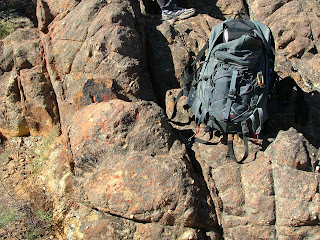The idea is that a glacier can flow, due to the pseudoplastic nature of ice. Just think of this like: as the huge ice sheet moves and gains momentum, more bonds holding the ice lattice together breaks and thus makes the flowing easier.. So now the glacier flows and mows the hell out of the ground upon which it's flowing! Shame the poor Nardouw Subgroup of the Cape Supergroup discovered this like 300 million years ago when the Dwyka decided to mow it down!
The result of this encounter can be seen in a town called Nieuwoudtville, which is now famous for it's flowers, waterfall and glacial pavement!
Below is a view of this famous glacial pavement in all its glory. You can see here what I meant by 'mow the hell outta the Nardouw' the Nardouw here has these deep striations, distinctive of glacial flow.

And try and figure out these two guys are.. It's like when the power rangers come together and make a bi machine to fight the bad guys..

Oh and the other thing Nieuwoudtville is known for: Harbouring the fugitive of the Cape stratigraphy.. Who is this you may ask?! Well it's the guy who resides between the Malmesbury and the Cape Supergroup.. Any ideas?
 Woah! It's the Vanrhynsdorp Group! Just there hiding below the Nardouw, he thought it was a good hiding spot, like my friend thought about his cave (enough said).. But then this waterfall totally uncovered him! Well there's something missing here.. Any ideas? Nardouw, ........., ..........., ............., Vanrhynsdorp. We don't give everything away you know..
Woah! It's the Vanrhynsdorp Group! Just there hiding below the Nardouw, he thought it was a good hiding spot, like my friend thought about his cave (enough said).. But then this waterfall totally uncovered him! Well there's something missing here.. Any ideas? Nardouw, ........., ..........., ............., Vanrhynsdorp. We don't give everything away you know..Ok so imagine this big ice sheet glacier thing, the top we call Supraglacial, the bottom Subglacial and inside the thing Englacial, and these are basically the different places where you can get deposition of sediments being transported by the glacier.
In the case where sediments are deposited directly from the glacier onto the land, we call this Tillite, like our friend the Dwyka tillite! Dwyka really doesn't care who you are, if you're in its ways it'll just mow you down and maybe even take you with for a long road trip! Like some unfortunate Ventersdorp lava clast discovered:
Below, the blackish, fine grained rock is the Dwyka tillite, and here note the several smaller clasts that got in its way and just got kidnapped, especially the big green clast, viz the Ventersdorp lava, far from home (~1600km)!

On the topic about the Dwyka kidnapping, sometimes the boulders that they kidnapped becomes quite a las, then the glacier will Drop the problem, and so forms the Drop stone! Cool hey! So nobody likes a spoil sport, so imagine you're the neatly horizontally bedded Witteberg shales and all of a sudden the Dwyka comes along and drops a dropstone, now this dropstone is your problem... and what a problem it is...
Below we can see how a dropstone has deformed the Witteberg shales, I'm pretty sure it's Witteberg anyway.. Oh and F.Y.I this is my geo hammer I lost in Oudtshoorn... I even saved a waypoint for god sake, yet it was gone! So keep an eye out next time you're around Oudtshoorn!


Here's some more Peninsula Formation that wasn't spared the wrath of the glacier! This time it was during the time of the Pakhuis Formation deposition. This striations mark the bedding plane of this Peninsula bed, and note that this is now subvertical which means that this bed must have been deformed after the striations were formed. Rounded Quartz pebbles are common in the Peninsula Formation and often display these striations.

Dont worry though the Peninsula is a tough cookie, below next to the cool backpack and German school note book, you'll notice the sandstone dykes protruding through the overlying Pakhuis! There's always a catch as you know, and in this case it's no different... One has to wonder how did the sandstones manage to intrude up into the Pakhuis?? Well I have an idea and if you want to maybe try your luck, leave the answer in a comment or drop an email and we'll see what you got!
These Peninsula sandstone dykes mark the top of the Peninsula and the bottom of the Pakhuis


Here's a hint: The answer for above may be responsible for this: (Not Scott btw)

Being in Cape Town, far away from active glacial deposition there's not much else to look for, but below is the Sneeukop member of the Pakhuis, which is kinda marks the top. So whats different here, this is firstly not a tillite, but rather this has been more likely been deposited by the melting of ice. This process would have produce a type of slump type of deposit, viz a diamictite. It's quite characteristic in that it has just a massive texture with clasts of all sizes.

Finally! The famous Maclears beacon above Table Mountain, has been called Pakhuis for quite some time now, but is it really? Who knows, but the vast array of pebbles in these rocks have lead people to believe it to represent a type of diamictite, while some have also apparently found striated pebbles, anyway if somebody out there is feeling for a hike, go and check it out and let us know what you think!

Later... . . . .
1 comment:
great blog. its a pity though that the only people who read it are US!!!!!!
good job though
Post a Comment